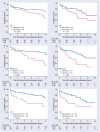Left atrial size predicts long-term outcome after balloon mitral valvuloplasty
- PMID: 36200547
- PMCID: PMC10635716
- DOI: 10.5603/CJ.a2022.0092
Left atrial size predicts long-term outcome after balloon mitral valvuloplasty
Abstract
Background: The treatment of choice for severe rheumatic mitral stenosis is balloon mitral valvuloplasty (BMV). Numerous predictors of immediate and long-term procedural success have been described. The aims of this study were to describe our experience with BMV over the last decade and to evaluate predictors of long-term event-free survival.
Methods: Medical records were retrospectively analyzed of patients who underwent BMV between 2009 and 2021. The primary outcome was a composite endpoint of all-cause mortality, mitral valve replacement (MVR), and repeat BMV. Long-term event-free survival was estimated using Kaplan-Meier curves. Logistic regression was used to create a multivariate model to assess pre-procedural predictors of the primary outcome.
Results: A total of 96 patients underwent BMV during the study period. The primary outcome occurred in 36 patients during 12-year follow-up: one (1%) patient underwent re-BMV, 28 (29%) underwent MVR, and eight (8%) died. Overall, event-free survival was 62% at 12 years. On multivariate analysis, pre-procedural left atrial volume index (LAVI) > 80 mL/m2 had a significant independent influence on event-free survival, as did previous mitral valve procedure and systolic pulmonary arterial pressure above 50 mmHg.
Conclusions: Despite being a relatively low-volume center, excellent short and long-term results were demonstrated, with event-free survival rates consistent with previous studies from high-volume centers. LAVI independently predicted long-term event-free survival.
Keywords: balloon mitral valvuloplasty; event-free survival; left atrial size; mitral stenosis; mitral valve.
Conflict of interest statement
Figures
References
-
- Inoue K, Owaki T, Nakamura T, et al. Clinical application of transvenous mitral commissurotomy by a new balloon catheter. J Thorac Cardiovasc Surg. 1984;87(3):394–402. - PubMed
-
- Otto CM, Nishimura RA, Bonow RO, et al. 2020 ACC/AHA guideline for the management of patients with valvular heart disease: a report of the American College of Cardiology/American Heart Association Joint Committee on Clinical Practice Guidelines. J Am Coll Cardiol. 2021;77(4):e25–e197. doi: 10.1016/j.jacc.2020.11.018. - DOI - PubMed
MeSH terms
LinkOut - more resources
Full Text Sources
Medical


